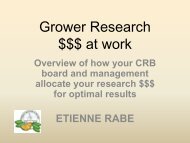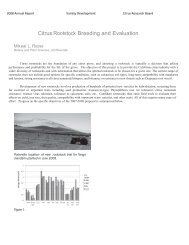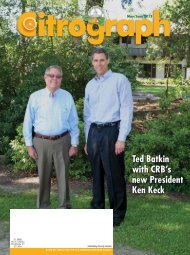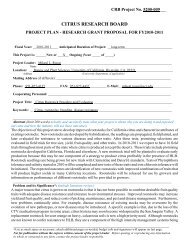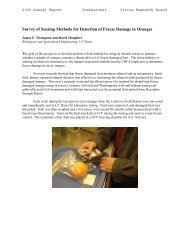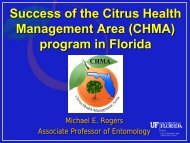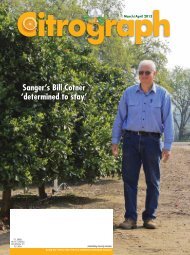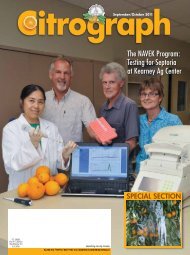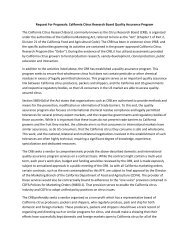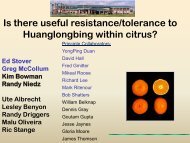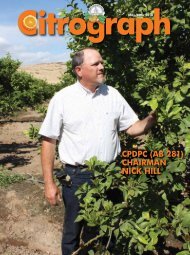Beth Grafton-Cardwell and her team at Lindcove - Citrus Research ...
Beth Grafton-Cardwell and her team at Lindcove - Citrus Research ...
Beth Grafton-Cardwell and her team at Lindcove - Citrus Research ...
You also want an ePaper? Increase the reach of your titles
YUMPU automatically turns print PDFs into web optimized ePapers that Google loves.
Background <strong>and</strong> initial evalu<strong>at</strong>ions<br />
of recently introduced cultivars distributed<br />
by the <strong>Citrus</strong> Clonal Protection Program<br />
Each year the <strong>Citrus</strong> Clonal Protection Program<br />
(CCPP) distributes budwood of new, potentially<br />
important commercial citrus cultivars as they are released<br />
from quarantine after completing a thorough “Variety<br />
Introduction (VI)” disease testing <strong>and</strong> t<strong>her</strong>apy program. An<br />
overview of this process was outlined in the March/April 2010<br />
(1: 20-26) issue of Citrograph, <strong>and</strong> a more detailed discussion<br />
of n<strong>at</strong>ional citrus quarantine <strong>and</strong> introduction programs was<br />
presented in a two-part series in the Citrograph in 2010 (Part I<br />
May/June 2010, 3: 26-35 <strong>and</strong> Part 2 July/August 2010, 4: 27-39).<br />
New cultivars for California come from the University<br />
of California Riverside citrus breeding program or are an<br />
introduction of cultivars or selections from within or outside<br />
the st<strong>at</strong>e. The CCPP provides budwood from these sources as<br />
soon as they are released from quarantine to make it possible<br />
for researc<strong>her</strong>s to evalu<strong>at</strong>e these selections <strong>and</strong> cultivars for<br />
the California citrus industry.<br />
Trees are propag<strong>at</strong>ed from budwood provided by the<br />
CCPP <strong>and</strong> are planted in three Introduction <strong>and</strong> Discovery<br />
Demonstr<strong>at</strong>ion Blocks (Demonstr<strong>at</strong>ion Blocks) of trees <strong>at</strong><br />
Riverside (UCR <strong>Citrus</strong> Variety Collection), Exeter (<strong>Lindcove</strong><br />
<strong>Research</strong> <strong>and</strong> Extension Center), <strong>and</strong> T<strong>her</strong>mal (Coachella<br />
Valley Agricultural <strong>Research</strong> Center). Demonstr<strong>at</strong>ion blocks<br />
provide system<strong>at</strong>ic means of collecting tree <strong>and</strong> fruit quality<br />
d<strong>at</strong>a on a large number of cultivars introduced from ot<strong>her</strong><br />
parts of the world. Each loc<strong>at</strong>ion has one to three trees on one<br />
or two rootstocks. In addition, demonstr<strong>at</strong>ion blocks provide<br />
venues for growers to view new cultivars in compar<strong>at</strong>ive plantings<br />
<strong>and</strong> provide feedback to the researc<strong>her</strong>s. Introductions<br />
<strong>and</strong> promising scion selections from the breeding program<br />
th<strong>at</strong> demonstr<strong>at</strong>e promise will be selected for incorpor<strong>at</strong>ion<br />
into replic<strong>at</strong>ed trials for more comprehensive evalu<strong>at</strong>ion for<br />
their commercial potential.<br />
This article is the second in a series of articles compiled<br />
by the staffs of the UCR <strong>Citrus</strong> Variety Collection (CVC),<br />
USDA N<strong>at</strong>ional Clonal Germplasm Repository for <strong>Citrus</strong> <strong>and</strong><br />
D<strong>at</strong>es (NCGRCD), <strong>and</strong> the CCPP. The first article appeared<br />
in the March/April 2010 (1: 20-26) issue of Citrograph. The<br />
purpose of this article is to provide inform<strong>at</strong>ion about these<br />
new cultivars. Although the CCPP staff provides budwood of<br />
new introductions to researc<strong>her</strong>s soon after release, very little<br />
or no d<strong>at</strong>a on the performance of these cultivars in California<br />
are available prior to when the CCPP distributes budwood<br />
of new cultivars to the industry as part of their Early Release<br />
Budwood Program.<br />
For the cultivars described below, listed under the Early<br />
Release Budwood program, we have inform<strong>at</strong>ion about them<br />
from their country of origin <strong>and</strong> the CCPP VI identific<strong>at</strong>ion<br />
number used for budwood distributions. For most, we also<br />
28 Citrograph July/August 2011<br />
Toni Siebert, Georgios Vidalakis, Robert Krueger, John Bash <strong>and</strong> Tracy Kahn<br />
have one to two years’ d<strong>at</strong>a on their performance in California.<br />
The final two cultivars included in this article are Rubidoux<br />
grapefruit hybrids which have been available from the CCPP<br />
for a while but for which very little was known. Below we provide<br />
available background inform<strong>at</strong>ion on these two hybrids<br />
<strong>and</strong> d<strong>at</strong>a on their fruit quality characteristics.<br />
Early release budwood<br />
“Early Release” budwood is budwood provided from<br />
selected cultivars th<strong>at</strong> are recently out of quarantine <strong>and</strong> are<br />
maintained by the CCPP <strong>at</strong> the LREC Protected Found<strong>at</strong>ion<br />
Blocks for the “Early Release” program. Young trees of these<br />
cultivars are grown in pots under protective screen <strong>and</strong> as a<br />
result, produce limited amounts of budwood which can be distributed.<br />
A signed “Waiver <strong>and</strong> Release” form must accompany<br />
all orders for Early Release Budwood since these cultivars are<br />
newly available <strong>and</strong> were released prior to extensive evalu<strong>at</strong>ions<br />
for trueness-to-type. The “Waiver <strong>and</strong> Release” form is available<br />
on the CCPP website (http://www.ccpp.ucr.edu).<br />
SRA 489 Marumi kumqu<strong>at</strong> (VI 673): The first distribution<br />
of buds from the CCPP occurred September 2010. This<br />
kumqu<strong>at</strong> variety is also known as the Round Kumqu<strong>at</strong>. Willits<br />
<strong>and</strong> Newcomb Nursery in Arvin, California sent budwood of<br />
‘Marumi’ kumqu<strong>at</strong> to the Germplasm Agrumes Collection<br />
<strong>at</strong> St<strong>at</strong>ion de Rec<strong>her</strong>ches Agronomiques (SRA), Corsica,<br />
France, in 1966. Budwood of this SRA 489 selection of Marumi<br />
was received by the <strong>Citrus</strong> Clonal Protection Program from<br />
INRA, San Giuliano, Corsica, France, in 1997. According to<br />
“The <strong>Citrus</strong> Industry” (1967), ‘Marumi’ kumqu<strong>at</strong> is the same<br />
as the ‘Maru’ or ‘Marumi kinkan’ of Japan.<br />
The fruit of ‘Marumi’ closely resembles ‘Nagami’ kumqu<strong>at</strong><br />
or oval kumqu<strong>at</strong> fruit, but ‘Marumi has a thinner <strong>and</strong><br />
somewh<strong>at</strong> sweeter rind. Hume (1926) describes the fruit of<br />
‘Marumi’ kumqu<strong>at</strong> as shaped like a sp<strong>her</strong>e or a sp<strong>her</strong>e fl<strong>at</strong>tened<br />
<strong>at</strong> the poles, “1 to 1 1/4 inches [2.5-3 cm] in diameter;<br />
golden yellow, short stalked; calyx small; rind smooth, thin,<br />
spicy to the taste <strong>and</strong> arom<strong>at</strong>ic when bruised; oil cells large;<br />
pulp sparse; juice acid; sections four to seven; seeds one to<br />
three, small, oval, greenish; cotyledons two, greenish”. Hume<br />
also reports th<strong>at</strong> the season for ‘Marumi’ is the same as Nagami<br />
kumqu<strong>at</strong>, m<strong>at</strong>uring in the winter <strong>and</strong> holding well on<br />
the tree.<br />
According to Hume (1926), ‘Marumi’ kumqu<strong>at</strong> trees are<br />
somewh<strong>at</strong> thorny, <strong>and</strong> leaves are oval in shape <strong>and</strong> somewh<strong>at</strong><br />
smaller <strong>and</strong> rounder <strong>at</strong> the apex with veins slightly more conspicuous<br />
than Nagami kumqu<strong>at</strong>. The leaves of ‘Marumi’ are<br />
borne on short rigid, inconspicuously winged petioles. “The<br />
<strong>Citrus</strong> Industry” (1967) also describes Marumi kumqu<strong>at</strong> trees<br />
as less vigorous than Nagami kumqu<strong>at</strong> trees.



